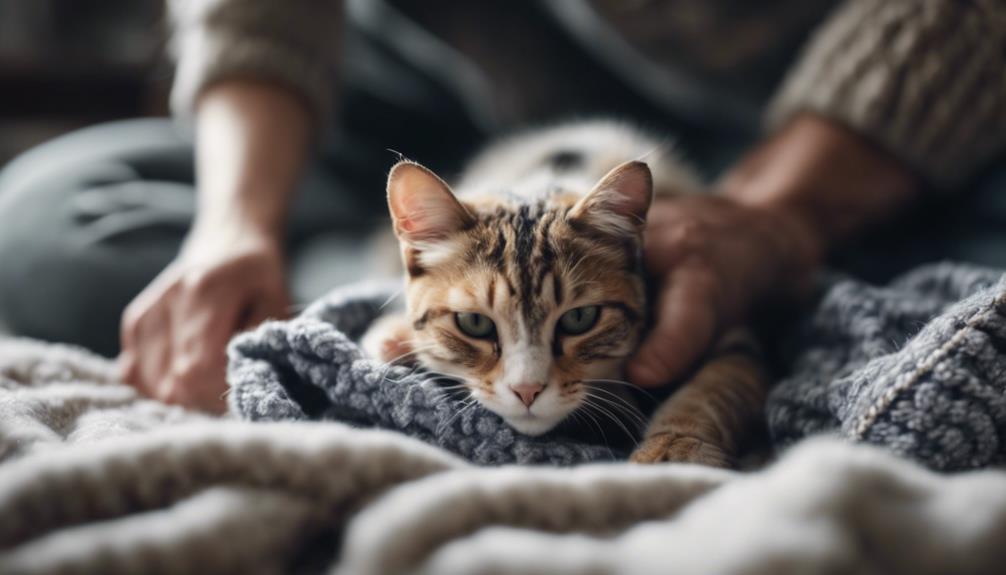Understanding the potential risks and implications of hypothermia in cats is a critical aspect of responsible pet ownership. Cats, particularly those who are vulnerable due to age or health conditions, can face serious consequences if affected by this medical emergency. Factors such as environmental conditions and individual breed characteristics play a significant role in a cat's susceptibility to hypothermia.
Recognizing the signs, knowing how to respond effectively, and taking preventive measures are all essential components of ensuring the well-being of our feline companions. By gaining insights into the prevention and treatment of hypothermia in cats, pet owners can better equip themselves to protect their beloved pets from this potentially life-threatening condition.
Key Takeaways
- Recognize signs like shivering and lethargy to identify hypothermia in cats early.
- Provide immediate warmth and veterinary care for severe hypothermia cases.
- Use preventive measures like attire and heated shelters to protect cats from hypothermia.
- Monitor environmental temperatures and keep cats indoors in cold weather to prevent hypothermia.
Understanding Hypothermia Causes in Cats
In felines, hypothermia can be triggered by exposure to cold, wet, or windy conditions, making it crucial for cat owners to be aware of environmental factors that can lead to this potentially dangerous condition.
Cats regulate their body temperature differently from humans, and factors such as fur length, health status, age, and breed characteristics can impact their ability to retain heat. Vulnerable cats, including kittens and senior cats, are at higher risk of developing hypothermia.
During cold weather, it is essential to provide adequate warmth and shelter for cats to prevent this condition. Understanding the causes of hypothermia in cats is key to safeguarding their well-being and ensuring they stay healthy and comfortable in varying environmental conditions.
Identifying Signs of Cat Hypothermia
Recognizing the signs of hypothermia in cats is crucial for prompt intervention and treatment to prevent further complications. Watch for shivering, a natural response to cold that may not suffice in hypothermia.
Check for cold paws, tail, nose, and ears, indicating heat redirection to the core. If your cat shows lethargy and seeks warmth by curling up, these are signs of moderate hypothermia.
Keep an eye out for pale gums as hypothermia worsens. Severe hypothermia manifests as slowed breathing, heart rate, dilated pupils, and potential collapse.
Being attentive to these signs can help you act swiftly to provide the necessary care and support to your cat in case of hypothermia.
Steps to Treat Cat Hypothermia

To effectively address cat hypothermia, immediate intervention is crucial to provide appropriate treatment and support for the affected feline. When faced with a cat suffering from hypothermia, it's essential to act swiftly and decisively. Here are three key steps to treat cat hypothermia that can make a difference in saving your furry friend:
- Wrap your cat in warm blankets: Enveloping your cat in cozy blankets can help raise their body temperature and provide comfort during this challenging time.
- Use warm water bottles: Placing warm water bottles close to your cat can aid in gradually rewarming their body and preventing further heat loss.
- Offer your body heat: Embrace your cat gently to transfer some of your body warmth, offering them a source of immediate heat and reassurance.
Preventing Cat Hypothermia Risks
One effective strategy for reducing cat hypothermia risks involves implementing appropriate measures to maintain optimal body temperature in feline companions. Cats should have access to warm shelter during cold weather, especially vulnerable ones like kittens or senior cats. Using attire such as sweaters, rain jackets, or coats can help cats retain body heat when outdoors.
It's crucial to keep cats indoors when temperatures drop below 45 degrees Fahrenheit to prevent hypothermia. Providing outdoor heated cat houses for neighborhood cats to seek warmth can also reduce the risk. Monitoring environmental temperatures and ensuring access to warm shelter are essential steps in protecting cats from hypothermia dangers.
Additional Resources for Cat Owners

For cat owners seeking further information and guidance on feline welfare, a range of valuable resources are available to enhance their understanding and support their efforts in caring for their beloved pets. Here are three essential resources that can provide additional insights and assistance:
- The American Society for the Prevention of Cruelty to Animals (ASPCA): A trusted source offering information on various cat health topics, including hypothermia prevention and treatment.
- The Cat Fanciers' Association (CFA): Provides breed-specific information and resources to help cat owners understand their cats' unique needs and vulnerabilities.
- Local Veterinary Clinics and Animal Shelters: These establishments often offer educational materials, workshops, and guidance on keeping cats safe and healthy, including during cold weather.
Frequently Asked Questions
Can Cats With Thick Fur Coats Still Be at Risk of Hypothermia?
While cats with thick fur coats have a natural advantage in retaining body heat, they can still be at risk of hypothermia, especially in severe cold conditions or if their fur becomes wet. Monitoring their exposure is crucial.
Are There Any Specific Breeds of Cats That Are More Susceptible to Hypothermia?
Certain cat breeds, like the Sphynx, Devon Rex, and Cornish Rex, with minimal fur coverage are more susceptible to hypothermia due to their lack of insulation. Monitoring these breeds closely in cold weather and providing adequate warmth is crucial.
How Can Owners Tell if Their Indoor Cat Is Experiencing Hypothermia?
Owners can identify indoor cat hypothermia through shivering, cold extremities, lethargy, and pale gums. Severe cases show slowed breathing, heart rate, and collapse. Act fast, move the cat to warmth, and seek veterinary care promptly for treatment.
Are There Any Common Household Items That Can Be Used to Help Warm up a Hypothermic Cat in an Emergency?
In an emergency, common household items like warm blankets, hot water bottles, and body heat can be used to help warm up a hypothermic cat. Immediate veterinary care is crucial for severe cases.
What Should Owners Do if They Suspect Their Cat Has Mild Hypothermia but Their Veterinarian Is Not Immediately Available?
If a cat shows signs of mild hypothermia and the vet is unavailable, move it to a warm, dry area, wrap in warm blankets, provide gentle heat sources, and monitor closely. Seek veterinary help promptly.
Conclusion
In conclusion, understanding the causes, signs, treatment, and prevention of hypothermia in cats is crucial for responsible pet owners.
By being aware of the risks and implications of this medical emergency, cat owners can take proactive measures to safeguard the well-being of their feline companions.
Recognizing the importance of prompt treatment and preventive strategies can help mitigate the dangers associated with hypothermia in cats, ensuring their health and safety.




